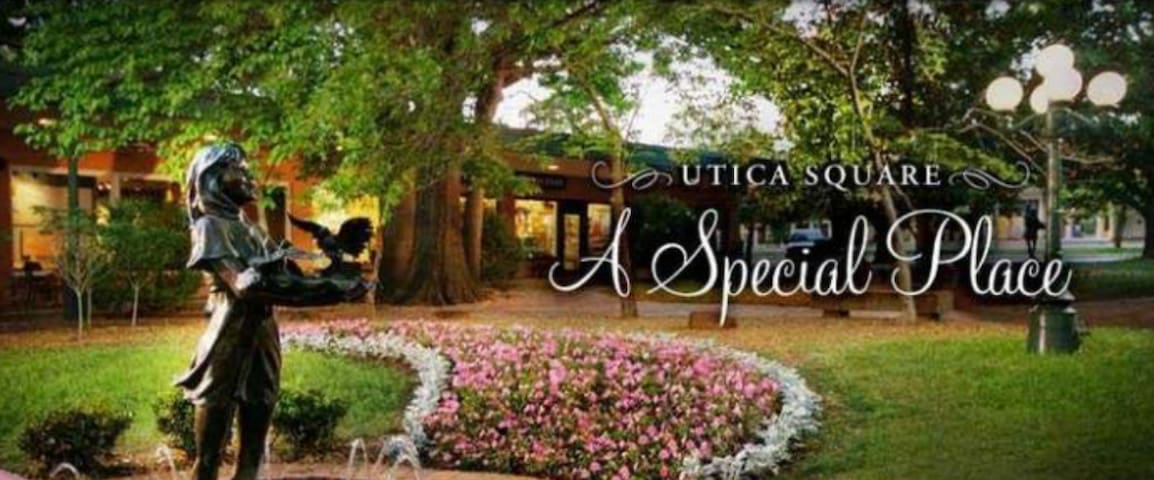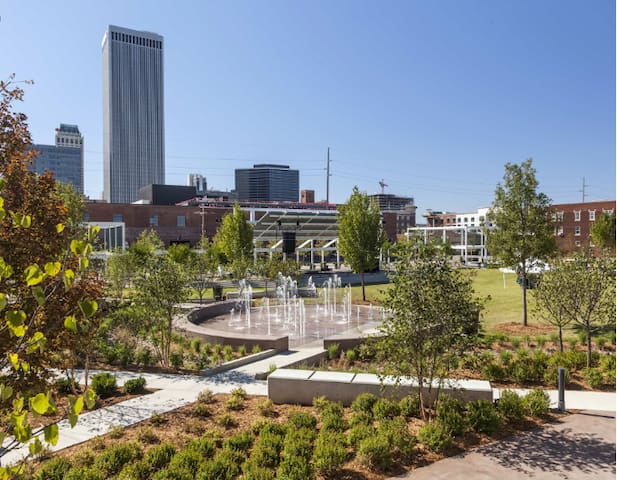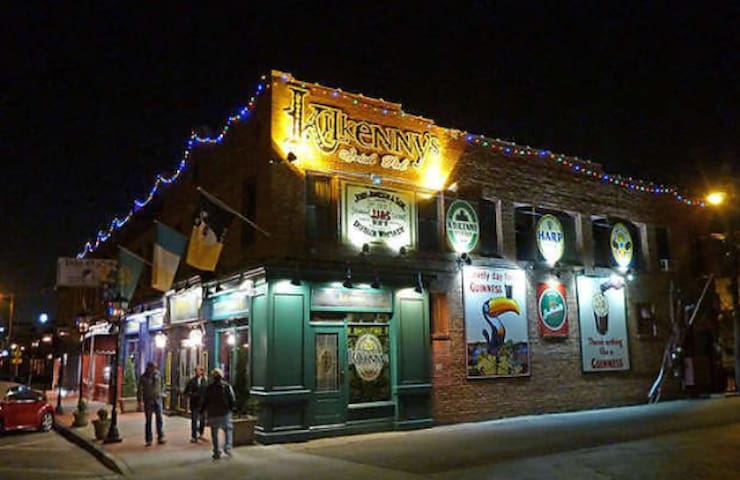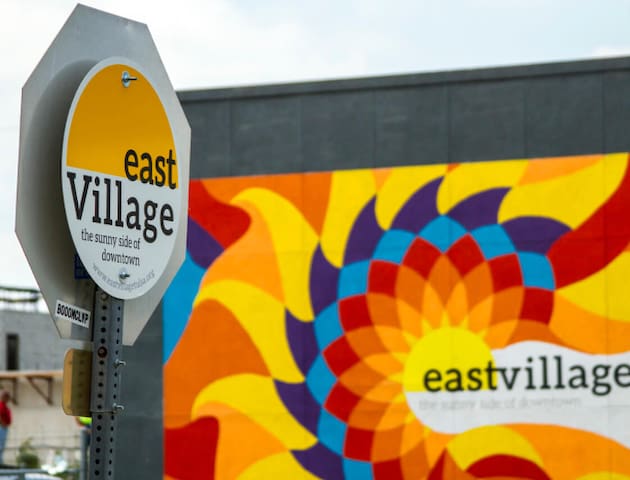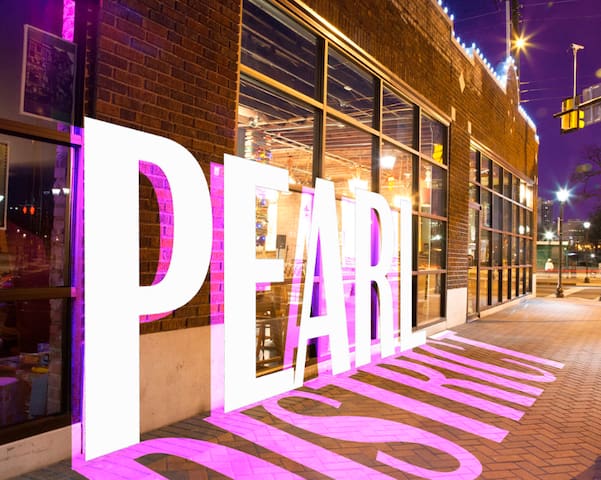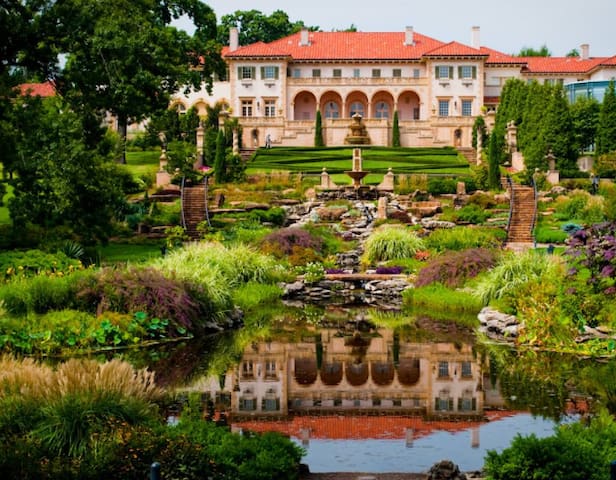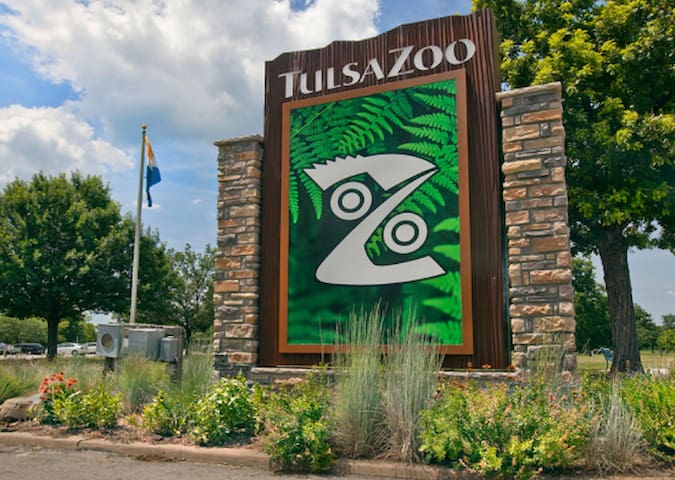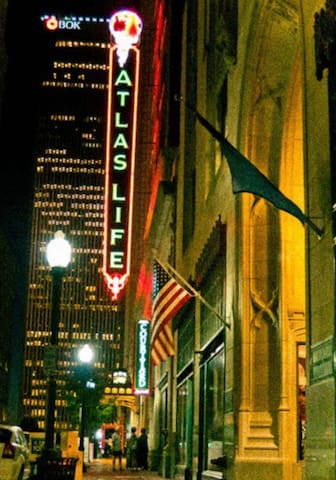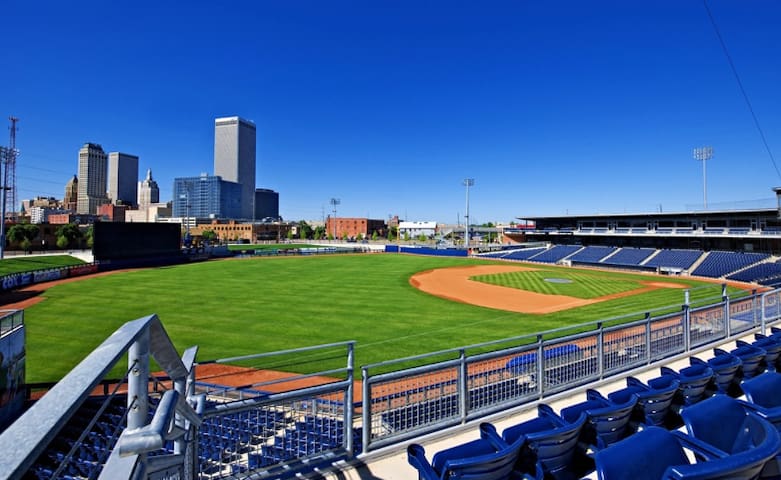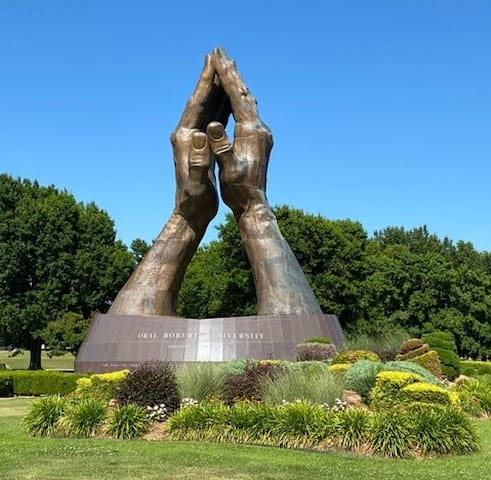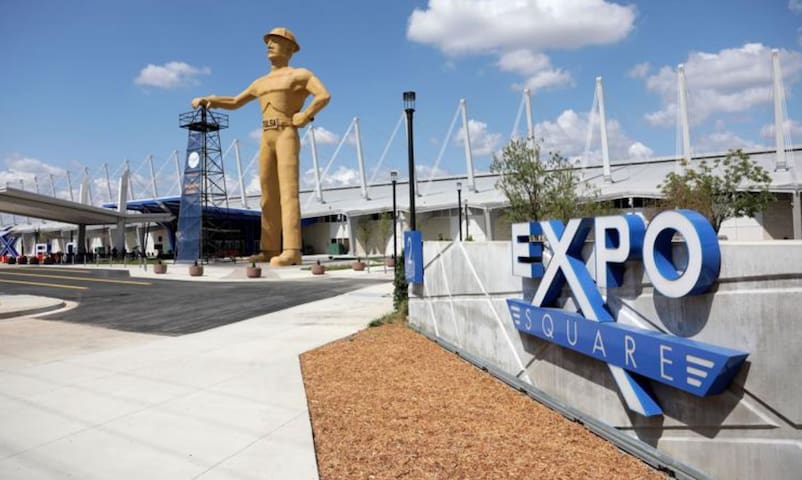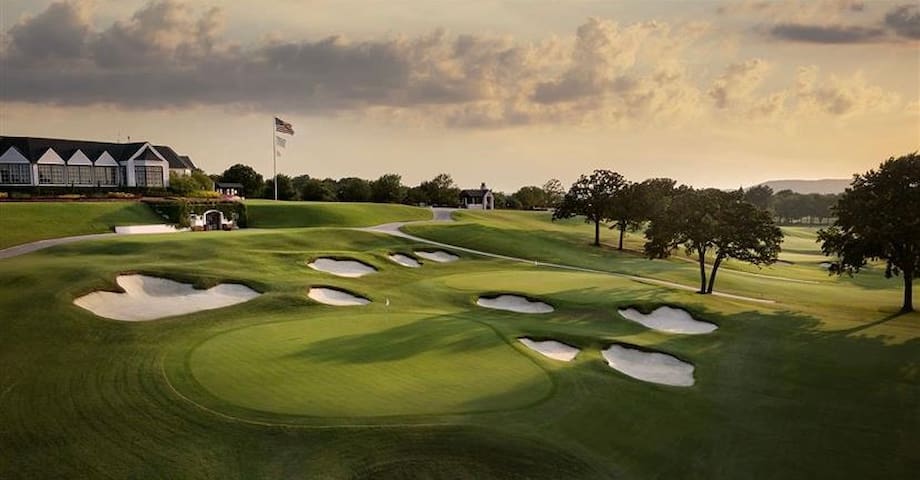Food scene
Utica Square is an upscale tree-lined outdoor shopping center open since 1952 in the heart of midtown Tulsa. The shopping center features a number of smaller, mostly independent shops, casual dining and upscale chain brand stores.
UTICA SQUARE SHOPPING:
Anthropology • Athletica • Banana Republic • Bath & Body Works • Cariloha • Coach
Coldwater Creek • Dog Dish • Gap • Gearhead Outfitters • Grand Vin Bottle Shop
Hicks Brunson Eyewear • J. Jill • J. Spencer Jewelry & Gifts • Jos. A. Bank • Kendra Scott L’Occitane • LaMode Cleaners • Loft • Madewell • Margo’s • Marmi • Moody’s Jewelry
Muse Intimates • New Balance • Pavilion Pendleton • Pottery Barn • Restorations Hardware • Saks Fifth Avenue • SALT Yoga • Stems • Suite One • Talbots
Ted’s Pipe Shoppe • Dolphin Fine Linens • The Lolly Garden • The Snow Goose • Walgreens • West Elm • White House/Black Market • Williams-Sonoma
UTICA SQUARE RESTAURANTS:
Ediblend Superfood Café $ • Fleming’s Prime Steakhouse & Wine Bar $$$ • Glacier Confection • Olive Garden $$ • P.F. Chang’s $$ • Pepper’s Grill $$ • Polo Grill $$$ • Queenie’s $ • Starbuck’s Coffee $ • Stonehorse Café $$$ • Stonehorse Market $$ • The Wild Fork $$
141 íbúar mæla með
Utica Square
1709 Utica SquareUtica Square is an upscale tree-lined outdoor shopping center open since 1952 in the heart of midtown Tulsa. The shopping center features a number of smaller, mostly independent shops, casual dining and upscale chain brand stores.
UTICA SQUARE SHOPPING:
Anthropology • Athletica • Banana Republic • Bath & Body Works • Cariloha • Coach
Coldwater Creek • Dog Dish • Gap • Gearhead Outfitters • Grand Vin Bottle Shop
Hicks Brunson Eyewear • J. Jill • J. Spencer Jewelry & Gifts • Jos. A. Bank • Kendra Scott L’Occitane • LaMode Cleaners • Loft • Madewell • Margo’s • Marmi • Moody’s Jewelry
Muse Intimates • New Balance • Pavilion Pendleton • Pottery Barn • Restorations Hardware • Saks Fifth Avenue • SALT Yoga • Stems • Suite One • Talbots
Ted’s Pipe Shoppe • Dolphin Fine Linens • The Lolly Garden • The Snow Goose • Walgreens • West Elm • White House/Black Market • Williams-Sonoma
UTICA SQUARE RESTAURANTS:
Ediblend Superfood Café $ • Fleming’s Prime Steakhouse & Wine Bar $$$ • Glacier Confection • Olive Garden $$ • P.F. Chang’s $$ • Pepper’s Grill $$ • Polo Grill $$$ • Queenie’s $ • Starbuck’s Coffee $ • Stonehorse Café $$$ • Stonehorse Market $$ • The Wild Fork $$
Formerly known as the Brady Arts District, the Tulsa Art District is located north across the Sante Fe Railroad tracks from the central business district and centered at Main Street & Brady Avenue. The Brady District is one of Tulsa's oldest areas, characterized by two-story brick warehouses. The Brady Theater, built between 1912 and 1914, was originally designed to serve as the city's municipal auditorium and was simply called "Convention Hall" for the first forty years of its life and was one of three internment camps where African Americans were detained after the 1921 Tulsa Race Riot. In 1952, major additions were added and the building was renamed Tulsa Municipal Theater. The building was listed on the National Register of Historic Places in 1979. Supplanted as the city auditorium in 1979 by construction of the Performing Arts Center in downtown, "the Old Lady on Brady" continues to be used today for a wide variety of concerts and theatrical productions.
North of the Brady on Main Street is the Cain's Ballroom, formerly the garage of the Brady family and the home of Bob Wills and his band, the Texas Playboys. The district is also the location of many local artists' galleries, restaurants with late night hours, bars and dance clubs. It is also an emerging gay neighborhood, with several gay or gay-friendly bars and numerous supportive shops and restaurants.
A few blocks southeast of Cain's Ballroom lies one of the gems of the Downtown Tulsa area- the Guthrie Green. This urban park is a cross between a garden and an amphitheater with events ranging from movie nights to workout classes hosted there. With family friendly concerts, food truck Wednesday's, and fountains to play in, the Guthrie Green has become a central point for the Tulsa Arts District. In fact, on the first Friday of every month, local businesses in this area center their First Friday Art Crawl around the Green, with exhibits at Philbrook Downtown, 108 Contemporary, Woody Guthrie Museum and the Hardesty Arts Center (AHHA) which border the park. This monthly event brings the community together to enjoy the best food, drinks, and entertainment that the Tulsa Arts District can provide.
Today, the Tulsa Arts District is one of the most diverse areas in all of Tulsa. It hosts restaurants, clubs, museums, and businesses and is a prime example of urban living. There is presently construction which will more than double the number of permanent residents in this artistic conclave. On its present path, the area will continue to develop as a hub of the community welcoming all people as it acknowledges its past while looking to a vibrant and inclusive future.
TULSA ARTS DISTRICT RESTAURANTS, BARS & SHOPPING:
The Tavern $$ • Sisserou’s Caribbean $$ • Prairie Artisan Ales $$ • Mexicali $
Chimera Café $ • Laffa Medi-Eastern $$ • Bull in The Alley $$$ • Pryhme Steakhouse $$$
Saturn Room $$ • Valkyrie $$ • Amelia’s $$$ • Yokozuna $$ • Duet $$$
Guthrie Green • Cain’s Ballroom • Brady Theater
Tulsa Performing Arts Center • AHHA Museum • Woody Guthrie Center
Philbrook Downtown Museum • Center of the Universe
45 íbúar mæla með
Brady Arts District
Formerly known as the Brady Arts District, the Tulsa Art District is located north across the Sante Fe Railroad tracks from the central business district and centered at Main Street & Brady Avenue. The Brady District is one of Tulsa's oldest areas, characterized by two-story brick warehouses. The Brady Theater, built between 1912 and 1914, was originally designed to serve as the city's municipal auditorium and was simply called "Convention Hall" for the first forty years of its life and was one of three internment camps where African Americans were detained after the 1921 Tulsa Race Riot. In 1952, major additions were added and the building was renamed Tulsa Municipal Theater. The building was listed on the National Register of Historic Places in 1979. Supplanted as the city auditorium in 1979 by construction of the Performing Arts Center in downtown, "the Old Lady on Brady" continues to be used today for a wide variety of concerts and theatrical productions.
North of the Brady on Main Street is the Cain's Ballroom, formerly the garage of the Brady family and the home of Bob Wills and his band, the Texas Playboys. The district is also the location of many local artists' galleries, restaurants with late night hours, bars and dance clubs. It is also an emerging gay neighborhood, with several gay or gay-friendly bars and numerous supportive shops and restaurants.
A few blocks southeast of Cain's Ballroom lies one of the gems of the Downtown Tulsa area- the Guthrie Green. This urban park is a cross between a garden and an amphitheater with events ranging from movie nights to workout classes hosted there. With family friendly concerts, food truck Wednesday's, and fountains to play in, the Guthrie Green has become a central point for the Tulsa Arts District. In fact, on the first Friday of every month, local businesses in this area center their First Friday Art Crawl around the Green, with exhibits at Philbrook Downtown, 108 Contemporary, Woody Guthrie Museum and the Hardesty Arts Center (AHHA) which border the park. This monthly event brings the community together to enjoy the best food, drinks, and entertainment that the Tulsa Arts District can provide.
Today, the Tulsa Arts District is one of the most diverse areas in all of Tulsa. It hosts restaurants, clubs, museums, and businesses and is a prime example of urban living. There is presently construction which will more than double the number of permanent residents in this artistic conclave. On its present path, the area will continue to develop as a hub of the community welcoming all people as it acknowledges its past while looking to a vibrant and inclusive future.
TULSA ARTS DISTRICT RESTAURANTS, BARS & SHOPPING:
The Tavern $$ • Sisserou’s Caribbean $$ • Prairie Artisan Ales $$ • Mexicali $
Chimera Café $ • Laffa Medi-Eastern $$ • Bull in The Alley $$$ • Pryhme Steakhouse $$$
Saturn Room $$ • Valkyrie $$ • Amelia’s $$$ • Yokozuna $$ • Duet $$$
Guthrie Green • Cain’s Ballroom • Brady Theater
Tulsa Performing Arts Center • AHHA Museum • Woody Guthrie Center
Philbrook Downtown Museum • Center of the Universe
Guthrie Green is an urban garden and performance space in the Tulsa Arts District of downtown Tulsa. Accommodating visitors looking for a peaceful escape or family activities, the park features a stage, The Dock pavilion, tree-lined paths, shade structures, water features and a large lawn. In addition to the markets, festivals and concerts planned for Guthrie Green, park visitors can enjoy a simple walk or lunch at the park to experience an urban green space unlike any other in Tulsa. Enjoy regular concerts, movies, fitness classes, food trucks, and much more at Guthrie Green. All events are free and open to the public!
94 íbúar mæla með
Guthrie Green
111 E Reconciliation WayGuthrie Green is an urban garden and performance space in the Tulsa Arts District of downtown Tulsa. Accommodating visitors looking for a peaceful escape or family activities, the park features a stage, The Dock pavilion, tree-lined paths, shade structures, water features and a large lawn. In addition to the markets, festivals and concerts planned for Guthrie Green, park visitors can enjoy a simple walk or lunch at the park to experience an urban green space unlike any other in Tulsa. Enjoy regular concerts, movies, fitness classes, food trucks, and much more at Guthrie Green. All events are free and open to the public!
Whether it's sampling one of over 20 restaurants in the area or viewing Tulsa's finest local and regional art galleries, Cherry Street offers entertainment for everyone. A hot spot for decades, Cherry Street features the highest number of locally owned businesses in town. The Cherry Street District is set near downtown in the northern midtown area. Visitors to this neighborhood find great shopping, particularly antiques and collectibles, a variety of local eateries, as well as some fabulous old homes in the surrounding residential areas.
CHERRY STREET RESTAURANTS:
Andolini’s Pizzeria $$ • Nola’s Creole & Cocktails $$ • Prossima Prosecco $$$ • Kilkenny’s Irish Pub & Restaurant $$ • Roosevelt’s $$ • The Coffee Shop $ • Mi Cocina $$ Smoke Woodfire Grill $$ • The Palace Café $$ • Chipotle $ • Hideaway Pizza $$ • Jason’s Deli $ Chimi’s $ • Crushed Red $ • Panera Bread $ • Salata $ • Taziki’s $ • Society $$
100 íbúar mæla með
Cherry Street
Whether it's sampling one of over 20 restaurants in the area or viewing Tulsa's finest local and regional art galleries, Cherry Street offers entertainment for everyone. A hot spot for decades, Cherry Street features the highest number of locally owned businesses in town. The Cherry Street District is set near downtown in the northern midtown area. Visitors to this neighborhood find great shopping, particularly antiques and collectibles, a variety of local eateries, as well as some fabulous old homes in the surrounding residential areas.
CHERRY STREET RESTAURANTS:
Andolini’s Pizzeria $$ • Nola’s Creole & Cocktails $$ • Prossima Prosecco $$$ • Kilkenny’s Irish Pub & Restaurant $$ • Roosevelt’s $$ • The Coffee Shop $ • Mi Cocina $$ Smoke Woodfire Grill $$ • The Palace Café $$ • Chipotle $ • Hideaway Pizza $$ • Jason’s Deli $ Chimi’s $ • Crushed Red $ • Panera Bread $ • Salata $ • Taziki’s $ • Society $$
East Village comprises 115 acres bordered by East 2nd and East 7th Streets, Detroit Avenue and Lansing Avenue, just inside the inner-dispersal loop. This area boasts an upscale martini bar, a hair salon, a pet day care, photography studios, lofts, a knitting room and living arts district, among others. The cornerstone of this neighborhood is the fifth largest LGBT community center in the United States, the Dennis R. Neill Equality Center, owned and operated by Oklahomans for Equality/OkEq (formerly Tulsa Oklahomans for Human Rights/TOHR), with further development being planned for more restaurants, residential lofts and retail.
The development in the East Village has provided Tulsans and visitors with many food and entertainment opportunities. With areas like the Bond Center for large events intertwined with luxurious apartment complexes, the feeling of community is particularly strong within this area. The Boxyard- a shopping complex made from repurposed shipping containers- has quickly become a popular destination for local shopping and eating within the East Village. The annual MOJO music fest occurs in this region, mixing live music with local craft beers and food trucks. Regardless of interest, the East Village District has something for everyone in Downtown Tulsa.
THE EAST VILLAGE RESTAURANTS, BARS & SHOPPING:
The Boxyard $ • East Village Bohemian Pizza $$ • Lowood $$$ • Hodges Bend $$
7 íbúar mæla með
East Village District
East Village comprises 115 acres bordered by East 2nd and East 7th Streets, Detroit Avenue and Lansing Avenue, just inside the inner-dispersal loop. This area boasts an upscale martini bar, a hair salon, a pet day care, photography studios, lofts, a knitting room and living arts district, among others. The cornerstone of this neighborhood is the fifth largest LGBT community center in the United States, the Dennis R. Neill Equality Center, owned and operated by Oklahomans for Equality/OkEq (formerly Tulsa Oklahomans for Human Rights/TOHR), with further development being planned for more restaurants, residential lofts and retail.
The development in the East Village has provided Tulsans and visitors with many food and entertainment opportunities. With areas like the Bond Center for large events intertwined with luxurious apartment complexes, the feeling of community is particularly strong within this area. The Boxyard- a shopping complex made from repurposed shipping containers- has quickly become a popular destination for local shopping and eating within the East Village. The annual MOJO music fest occurs in this region, mixing live music with local craft beers and food trucks. Regardless of interest, the East Village District has something for everyone in Downtown Tulsa.
THE EAST VILLAGE RESTAURANTS, BARS & SHOPPING:
The Boxyard $ • East Village Bohemian Pizza $$ • Lowood $$$ • Hodges Bend $$
Another popular downtown entertainment district is the Blue Dome, named for a distinctive, domed building at Second Street and Elgin Avenue, in the area in the eastern section of downtown. The building was originally constructed in 1924 as a Gulf Oil service station. It has been converted to an information desk/office for the district, and is about two blocks south of the OneOK field.
The Blue Dome District is known for its local dining options, large art festival, and scenic Downtown Tulsa views. Every May, the Blue Dome Arts Festival allows families to enjoy local music and street vendors surrounding the historic dome. Further, there is no bad angle for pictures of Tulsa's infamous skyline in this district. With so many delicious restaurants and walkable views, it is no wonder that the Blue Dome District continues to bring its unique art scene to Tulsa.
BLUE DOME DISTRICT RESTAURANTS, BARS & SHOPPING:
Prospect Local Bar and Kitchen $$ • Roof Sixty Six Bar $$ • Dust Bowl $
Vintage Wine Bar $$ • Peacemaker Lobster and Crab Co. $$ • Jinya Ramen Bar $$
Fassler Hall $ • Juniper $$$ • Dilly Diner $$ • Albert G’s BBQ $ • McNellie’s Pub $$
La Tertullia $$ • The Max Retropub $ • Arnie’s Bar $
41 íbúar mæla með
Blue Dome District
Another popular downtown entertainment district is the Blue Dome, named for a distinctive, domed building at Second Street and Elgin Avenue, in the area in the eastern section of downtown. The building was originally constructed in 1924 as a Gulf Oil service station. It has been converted to an information desk/office for the district, and is about two blocks south of the OneOK field.
The Blue Dome District is known for its local dining options, large art festival, and scenic Downtown Tulsa views. Every May, the Blue Dome Arts Festival allows families to enjoy local music and street vendors surrounding the historic dome. Further, there is no bad angle for pictures of Tulsa's infamous skyline in this district. With so many delicious restaurants and walkable views, it is no wonder that the Blue Dome District continues to bring its unique art scene to Tulsa.
BLUE DOME DISTRICT RESTAURANTS, BARS & SHOPPING:
Prospect Local Bar and Kitchen $$ • Roof Sixty Six Bar $$ • Dust Bowl $
Vintage Wine Bar $$ • Peacemaker Lobster and Crab Co. $$ • Jinya Ramen Bar $$
Fassler Hall $ • Juniper $$$ • Dilly Diner $$ • Albert G’s BBQ $ • McNellie’s Pub $$
La Tertullia $$ • The Max Retropub $ • Arnie’s Bar $
For nearly 20 years, the Pearl District Association has united residents, business owners, and city government behind a series of plans that have turned this once neglected expanse east of downtown into an "overnight" success. The Pearl is up-and-coming by design — made with the people wanting to make their lives and livelihoods here.
THE PEARL RESTAURANTS:
Bramble $$ • Ike’s Chili $ • The Wildflower Café $ • The Coffee Blues $ • Mangoes Cuban Café $ • El Rancho Grande $ • Freeway Café $ • Cirque Coffee
23 íbúar mæla með
The Pearl
For nearly 20 years, the Pearl District Association has united residents, business owners, and city government behind a series of plans that have turned this once neglected expanse east of downtown into an "overnight" success. The Pearl is up-and-coming by design — made with the people wanting to make their lives and livelihoods here.
THE PEARL RESTAURANTS:
Bramble $$ • Ike’s Chili $ • The Wildflower Café $ • The Coffee Blues $ • Mangoes Cuban Café $ • El Rancho Grande $ • Freeway Café $ • Cirque Coffee
Sightseeing
Tulsa includes many structures built during the Oil Boom in the 1920s and 1930s, including Art Deco buildings such as the Mid-Continent Tower, Boston Avenue Methodist Church, and the Exchange Bank Building (today known as the 320 South Boston Building). Oilman Waite Phillips, left a significant architectural impact on downtown Tulsa through the Philtower and Philcade buildings. Other notable Tulsa buildings include the Atlas Life Building, Holy Family Cathedral, Holy Trinity Greek Orthodox Church, and the Mayo Hotel, the former of which once served as home to J. Paul Getty. Known for a time as "Terra Cotta City", Tulsa hosted the International Sixth Congress on Art Deco in 2001.
Downtown Tulsa is in the northwest quadrant of the city and is ringed by an expressway system called the inner dispersal loop. Downtown's buildings include many large office towers. At 667 ft (203 m), the BOK Tower (formerly One Williams Center) was the tallest building in any of the 5 "plains states" (Oklahoma, Kansas, Nebraska, North Dakota and South Dakota) until the Devon Tower in Oklahoma City was completed in 2012. The BOK Tower was designed in 1975 by Minoru Yamasaki & Associates, the same architect who designed the World Trade Center in New York City.
The Tulsa Performing Arts Center occupies a half city block in Tulsa's historical downtown. The PAC is also the design of Minoru Yamasaki. It houses five theatres and a reception hall. More than a quarter of a million people visit the Center each year to attend a performance from one of Tulsa's seven acclaimed musical and dramatic companies including the Tulsa Ballet, Tulsa Symphony Orchestra, Tulsa Opera, and a variety of symphonic groups. The PAC hosts a multitude of cultural events through the fall, winter and spring.
In 2005 the City of Tulsa broke ground on a 19,199 seat regional events center designed by architect César Pelli. The arena was named the BOK Center (or Bank of Oklahoma Center) and opened on August 30, 2008.
37 íbúar mæla með
Downtown
Tulsa includes many structures built during the Oil Boom in the 1920s and 1930s, including Art Deco buildings such as the Mid-Continent Tower, Boston Avenue Methodist Church, and the Exchange Bank Building (today known as the 320 South Boston Building). Oilman Waite Phillips, left a significant architectural impact on downtown Tulsa through the Philtower and Philcade buildings. Other notable Tulsa buildings include the Atlas Life Building, Holy Family Cathedral, Holy Trinity Greek Orthodox Church, and the Mayo Hotel, the former of which once served as home to J. Paul Getty. Known for a time as "Terra Cotta City", Tulsa hosted the International Sixth Congress on Art Deco in 2001.
Downtown Tulsa is in the northwest quadrant of the city and is ringed by an expressway system called the inner dispersal loop. Downtown's buildings include many large office towers. At 667 ft (203 m), the BOK Tower (formerly One Williams Center) was the tallest building in any of the 5 "plains states" (Oklahoma, Kansas, Nebraska, North Dakota and South Dakota) until the Devon Tower in Oklahoma City was completed in 2012. The BOK Tower was designed in 1975 by Minoru Yamasaki & Associates, the same architect who designed the World Trade Center in New York City.
The Tulsa Performing Arts Center occupies a half city block in Tulsa's historical downtown. The PAC is also the design of Minoru Yamasaki. It houses five theatres and a reception hall. More than a quarter of a million people visit the Center each year to attend a performance from one of Tulsa's seven acclaimed musical and dramatic companies including the Tulsa Ballet, Tulsa Symphony Orchestra, Tulsa Opera, and a variety of symphonic groups. The PAC hosts a multitude of cultural events through the fall, winter and spring.
In 2005 the City of Tulsa broke ground on a 19,199 seat regional events center designed by architect César Pelli. The arena was named the BOK Center (or Bank of Oklahoma Center) and opened on August 30, 2008.
Tulsa’s Gathering Place was named the Best New Attraction in the nation in 2018 through the USA Today Readers’ Choice awards. In 2019, Gathering Place made Time Magazine's list of The World's 100 Greatest Places of 2019. The main attractions are the Chapman Adventure Playground, the Williams Lodge, a boathouse, splash playground, great lawn, outdoor sports courts, a skate park, a wetland pond and garden, and numerous trails among other locations. There are plenty of activities for kids and adults alike.
277 íbúar mæla með
Gathering Place
2650 South John Williams WayTulsa’s Gathering Place was named the Best New Attraction in the nation in 2018 through the USA Today Readers’ Choice awards. In 2019, Gathering Place made Time Magazine's list of The World's 100 Greatest Places of 2019. The main attractions are the Chapman Adventure Playground, the Williams Lodge, a boathouse, splash playground, great lawn, outdoor sports courts, a skate park, a wetland pond and garden, and numerous trails among other locations. There are plenty of activities for kids and adults alike.
Tulsa Botanic Garden is developing on 170 acres just northwest of downtown Tulsa. Explore the A.R. and Marylouise Tandy Floral Terraces, an ornamental garden featuring over 8,000 trees, shrubs, and perennials as well as one of the largest spring bulb displays in the state. The Children's Discovery Garden offers hands-on fun for all ages with carnivorous plants, a tree fort, insect whirligigs and the one-of-a-kind Spring Giant. Nature lovers and birders will enjoy hiking a trail through both tallgrass prairie and Cross Timbers forest.
47 íbúar mæla með
Tulsa Grasagarður
3900 Tulsa Botanic DrTulsa Botanic Garden is developing on 170 acres just northwest of downtown Tulsa. Explore the A.R. and Marylouise Tandy Floral Terraces, an ornamental garden featuring over 8,000 trees, shrubs, and perennials as well as one of the largest spring bulb displays in the state. The Children's Discovery Garden offers hands-on fun for all ages with carnivorous plants, a tree fort, insect whirligigs and the one-of-a-kind Spring Giant. Nature lovers and birders will enjoy hiking a trail through both tallgrass prairie and Cross Timbers forest.
The Philbrook Museum of Art is an art museum in the historic home of Waite and Genevieve Phillips with expansive formal gardens located in Tulsa, Oklahoma featuring two locations. The main site is located in part in a former 1920s villa, and a satellite facility known as Philbrook Downtown, is found in Tulsa's Brady Arts District. Showcasing nine collections of art from all over the world, and spanning various artistic media and styles, the cornerstone collection focuses on Native American art featuring basketry, pottery, paintings and jewelry.
237 íbúar mæla með
Philbrook Listasafn
2727 S Rockford RdThe Philbrook Museum of Art is an art museum in the historic home of Waite and Genevieve Phillips with expansive formal gardens located in Tulsa, Oklahoma featuring two locations. The main site is located in part in a former 1920s villa, and a satellite facility known as Philbrook Downtown, is found in Tulsa's Brady Arts District. Showcasing nine collections of art from all over the world, and spanning various artistic media and styles, the cornerstone collection focuses on Native American art featuring basketry, pottery, paintings and jewelry.
The Tulsa Zoo is a 85-acre non-profit zoo located in Tulsa, Oklahoma, United States. The Tulsa Zoo is owned by the City of Tulsa, but since 2010 has been privately managed by Tulsa Zoo Management, Inc. The zoo is located in Mohawk Park, one of the largest municipal parks in the United States. The zoo is involved in many conservation efforts, such as a push to reduce the use of palm oil, FrogWatch USA, and efforts to encourage ocean conservation.
105 íbúar mæla með
Tulsa dýragarður
6421 E 36th St NThe Tulsa Zoo is a 85-acre non-profit zoo located in Tulsa, Oklahoma, United States. The Tulsa Zoo is owned by the City of Tulsa, but since 2010 has been privately managed by Tulsa Zoo Management, Inc. The zoo is located in Mohawk Park, one of the largest municipal parks in the United States. The zoo is involved in many conservation efforts, such as a push to reduce the use of palm oil, FrogWatch USA, and efforts to encourage ocean conservation.
Tulsa boasts one of the nation’s most extensive collections of Art Deco architecture, which is most visible in the downtown Deco District. This region spans the area from 1st to 8th street, with borders at Boston and Cheyenne. This area is located in the heart of the skyscrapers of Downtown Tulsa and thus has many food, beverage, and fitness options readily available. The Bartlett Square at 5th and Main provides a unique European feel to this region, but the entire area is overflowing with Tulsa charm.
The Philtower and Philcade buildings, the Atlas Life building, The Mayo Hotel, Tulsa Club, and Public Service Company of Oklahoma building are some of the most prominent displays of the Art Deco architecture style in Tulsa. Many tours of this region are readily available. Perhaps one of the more interesting facts about the Art Deco region are the tunnels which connect many of the classic buildings. They are now open for public tours, providing interested guests with a one of a kind Tulsa experience. Beyond the extensive variety of local shops and restaurants, this district annually hosts one of the largest festivals in Tulsa: Mayfest. Every May, the Deco District comes alive during Mayfest, where artists, vendors, and live musicians combine to create one of the largest street festivals in Tulsa.
DECO DISTRICT RESTAURANTS, BARS & SHOPPING:
Boston Title & Abstract $$$ • Ti Amo $$ • The Vault $$ • Elote Café $
Roppongi $ • The Mayo Hotel $$$ • The Boulder Grill $$ • Daily Grill $
10 íbúar mæla með
Deco District
Tulsa boasts one of the nation’s most extensive collections of Art Deco architecture, which is most visible in the downtown Deco District. This region spans the area from 1st to 8th street, with borders at Boston and Cheyenne. This area is located in the heart of the skyscrapers of Downtown Tulsa and thus has many food, beverage, and fitness options readily available. The Bartlett Square at 5th and Main provides a unique European feel to this region, but the entire area is overflowing with Tulsa charm.
The Philtower and Philcade buildings, the Atlas Life building, The Mayo Hotel, Tulsa Club, and Public Service Company of Oklahoma building are some of the most prominent displays of the Art Deco architecture style in Tulsa. Many tours of this region are readily available. Perhaps one of the more interesting facts about the Art Deco region are the tunnels which connect many of the classic buildings. They are now open for public tours, providing interested guests with a one of a kind Tulsa experience. Beyond the extensive variety of local shops and restaurants, this district annually hosts one of the largest festivals in Tulsa: Mayfest. Every May, the Deco District comes alive during Mayfest, where artists, vendors, and live musicians combine to create one of the largest street festivals in Tulsa.
DECO DISTRICT RESTAURANTS, BARS & SHOPPING:
Boston Title & Abstract $$$ • Ti Amo $$ • The Vault $$ • Elote Café $
Roppongi $ • The Mayo Hotel $$$ • The Boulder Grill $$ • Daily Grill $
The Greenwood Historical District is just north of downtown and east of the Brady District. It was once one of the most affluent African-American communities in the United States and referred to as Black Wall Street. In 1921, thirty-five blocks of businesses and residences were burned in this district during the infamous Tulsa Race Riot, the bloodiest racial riot in the history of the United States. The Oklahoma Legislature passed laws in 2001 aimed at revitalizing Greenwood, setting up a scholarship fund for college-bound descendants of riot victims and appropriating $2 million for a riot memorial. As of 2004, two blocks of the old neighborhood have been restored and are part of the Greenwood Historical District. It is now home to the Greenwood Cultural Center, the Tulsa Race Riot Memorial, and the Oklahoma Jazz Hall of Fame, as well as Oklahoma State University - Tulsa and Langston University-Tulsa.
Because of its rich history, the Greenwood Historical District provides visitors with one of the most unique cultural experiences in Tulsa. The John Hope Franklin Reconciliation Park details the relationship between African-Americans and the state of Oklahoma throughout history with an emphasis on the Tulsa Race Riot. The Mabel B Little Heritage House takes visitors back to the 1920s with its classic furnishings and information about the Riots. The Greenwood Cultural Center strives to educate on the unique history of the Greenwood District, with a focus on jazz and the blues as well. Alongside these important landmarks in the Greenwood District lies a growing retail district bordering OneOK Field on the east.
GREENWOOD HISTORICAL DISTRICT RESTAURANT, BARS & SHOPPING:
Lefty’s on Greenwood $ • Fat Guy’s Burger $ • Elgin Park $
ONEOK Baseball Field • Greenwood Cultural Center
28 íbúar mæla með
Greenwood District
The Greenwood Historical District is just north of downtown and east of the Brady District. It was once one of the most affluent African-American communities in the United States and referred to as Black Wall Street. In 1921, thirty-five blocks of businesses and residences were burned in this district during the infamous Tulsa Race Riot, the bloodiest racial riot in the history of the United States. The Oklahoma Legislature passed laws in 2001 aimed at revitalizing Greenwood, setting up a scholarship fund for college-bound descendants of riot victims and appropriating $2 million for a riot memorial. As of 2004, two blocks of the old neighborhood have been restored and are part of the Greenwood Historical District. It is now home to the Greenwood Cultural Center, the Tulsa Race Riot Memorial, and the Oklahoma Jazz Hall of Fame, as well as Oklahoma State University - Tulsa and Langston University-Tulsa.
Because of its rich history, the Greenwood Historical District provides visitors with one of the most unique cultural experiences in Tulsa. The John Hope Franklin Reconciliation Park details the relationship between African-Americans and the state of Oklahoma throughout history with an emphasis on the Tulsa Race Riot. The Mabel B Little Heritage House takes visitors back to the 1920s with its classic furnishings and information about the Riots. The Greenwood Cultural Center strives to educate on the unique history of the Greenwood District, with a focus on jazz and the blues as well. Alongside these important landmarks in the Greenwood District lies a growing retail district bordering OneOK Field on the east.
GREENWOOD HISTORICAL DISTRICT RESTAURANT, BARS & SHOPPING:
Lefty’s on Greenwood $ • Fat Guy’s Burger $ • Elgin Park $
ONEOK Baseball Field • Greenwood Cultural Center
The Oklahoma Aquarium is home to the world's largest exhibit of bull sharks which you can explore in the unique, walk through tunnel. You can also see their loggerhead sea turtles, zebra sharks, and humphead wrasse. As of 2020, the aquarium has more than 500 species and 10,000 animals.
61 íbúar mæla með
Oklahoma Aquarium
300 Aquarium DrThe Oklahoma Aquarium is home to the world's largest exhibit of bull sharks which you can explore in the unique, walk through tunnel. You can also see their loggerhead sea turtles, zebra sharks, and humphead wrasse. As of 2020, the aquarium has more than 500 species and 10,000 animals.
Oral Roberts University (ORU) is a private evangelical university in Tulsa, Oklahoma. Founded in 1963, the university is named after its founder, evangelist Oral Roberts.
Sitting on a 323-acre (1.31 km2) campus, ORU offers over 70 undergraduate degree programs along with 20 graduate programs across six colleges. ORU is classified among "Baccalaureate Colleges: Diverse Fields". Most popular majors include ministry and leadership, nursing, engineering, psychology, and business administration. The university enrolls approximately 4,000 students.
27 íbúar mæla með
Oral Roberts University
7777 S Lewis AveOral Roberts University (ORU) is a private evangelical university in Tulsa, Oklahoma. Founded in 1963, the university is named after its founder, evangelist Oral Roberts.
Sitting on a 323-acre (1.31 km2) campus, ORU offers over 70 undergraduate degree programs along with 20 graduate programs across six colleges. ORU is classified among "Baccalaureate Colleges: Diverse Fields". Most popular majors include ministry and leadership, nursing, engineering, psychology, and business administration. The university enrolls approximately 4,000 students.
As the first county park in Oklahoma, the 270-acres features over 700 trees, 11 ponds, and more than 100,000 visitors a year. There is an 18-hole championship golf course, a lighted driving range, pro shop and the only lighted 18-hole par 3 in Oklahoma. It’s a spectacular setting for all occasions with indoor and outdoor event spaces. Northeast of the golf course is the nationally recognized Case Tennis Center at LaFortune Park. Built in 1970, it has grown from 6 courts to 21 lighted outdoor courts, 3 air-conditioned indoor courts and a full-service pro shop with locker rooms. LaFortune Park also features a 5k-walking/running trail that encompasses the entire park, frequently used for team building, corporate challenges and fundraising events.
21 íbúar mæla með
LaFortune Park
5202 S Hudson AveAs the first county park in Oklahoma, the 270-acres features over 700 trees, 11 ponds, and more than 100,000 visitors a year. There is an 18-hole championship golf course, a lighted driving range, pro shop and the only lighted 18-hole par 3 in Oklahoma. It’s a spectacular setting for all occasions with indoor and outdoor event spaces. Northeast of the golf course is the nationally recognized Case Tennis Center at LaFortune Park. Built in 1970, it has grown from 6 courts to 21 lighted outdoor courts, 3 air-conditioned indoor courts and a full-service pro shop with locker rooms. LaFortune Park also features a 5k-walking/running trail that encompasses the entire park, frequently used for team building, corporate challenges and fundraising events.
The Expo Square Pavilion, sometimes called simply The Pavilion, and formerly known as the Tulsa Fairgrounds Pavilion, is a 6,311-seat multi-purpose arena, in the Tulsa State Fairgrounds in Tulsa, Oklahoma. It was built in 1932; the architect was Leland I Shumway. The building is in the PWA Art Deco style, built of blond brick with terra cotta ornamentation, and is considered one of the prime examples of Art Deco architecture in Tulsa.
6 íbúar mæla með
Tulsa Expo Center
The Expo Square Pavilion, sometimes called simply The Pavilion, and formerly known as the Tulsa Fairgrounds Pavilion, is a 6,311-seat multi-purpose arena, in the Tulsa State Fairgrounds in Tulsa, Oklahoma. It was built in 1932; the architect was Leland I Shumway. The building is in the PWA Art Deco style, built of blond brick with terra cotta ornamentation, and is considered one of the prime examples of Art Deco architecture in Tulsa.
Southern Hills Country Club is a private golf and country club in Tulsa, Oklahoma. Southern Hills has hosted seven major championships for men, including the U.S. Open three times (1958, 1977, 2001) and four PGA Championships (1970, 1982, 1994, 2007). It is the only course to host the PGA Championship four times, and will host its fifth PGA Championship in 2022.
17 íbúar mæla með
Southern Hills Country Club
2636 E 61st StSouthern Hills Country Club is a private golf and country club in Tulsa, Oklahoma. Southern Hills has hosted seven major championships for men, including the U.S. Open three times (1958, 1977, 2001) and four PGA Championships (1970, 1982, 1994, 2007). It is the only course to host the PGA Championship four times, and will host its fifth PGA Championship in 2022.

